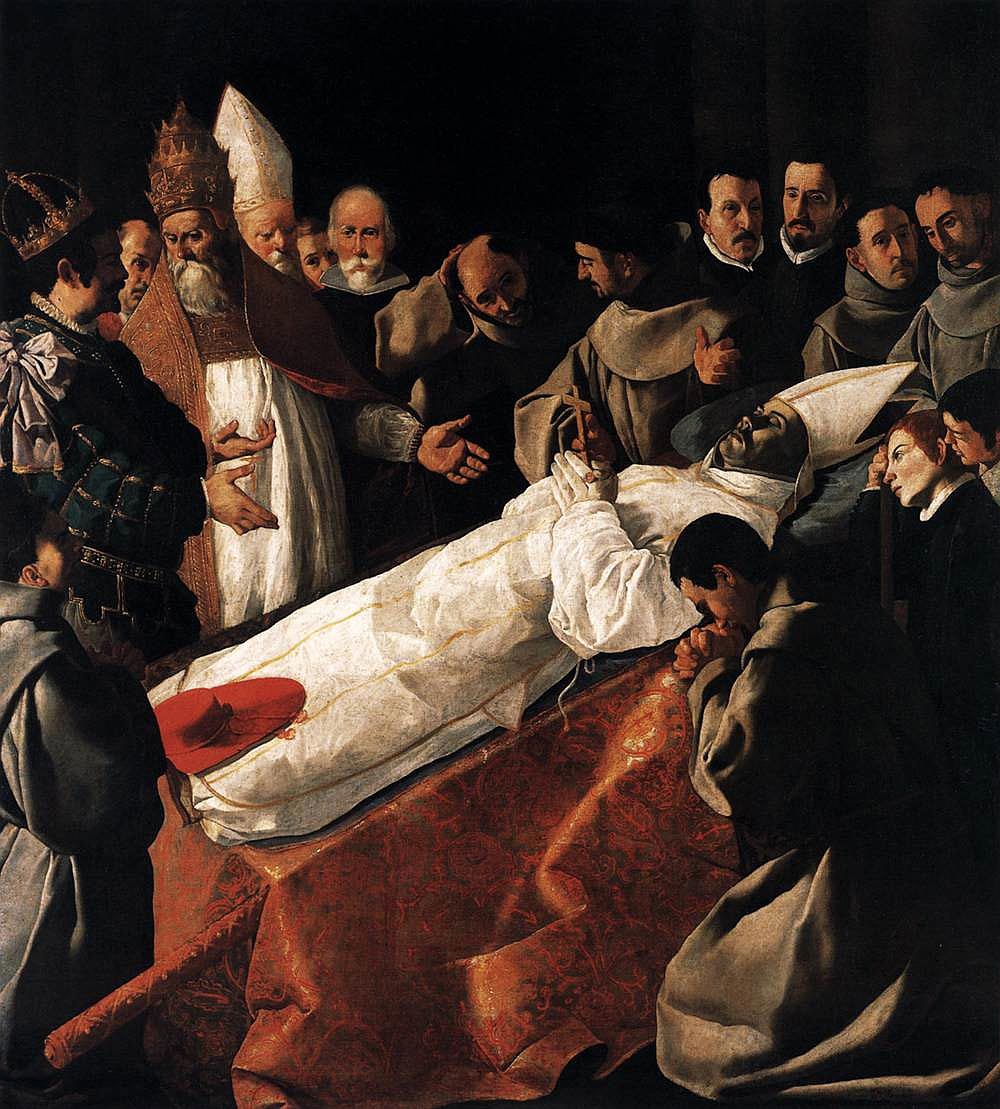| Francisco de Zurbarán | |
|---|---|
 |
|
| Born | Nov. 7, 1598 Fuente de Cantos, Extremadura |
| Died | Aug. 27, 1664 (at age 65) Madrid |
| Nationality | Spanish |
| Movement | Baroque |
| Field | Painting |
| Works | View Complete Works |
Francisco de Zurbarán (1598-1664) was a Spanish painter who is best known for his still-life pictures and for his religious themes. Most of his religious works depict figures such as martyrs, monks, and nuns. Because of his skill at depicting realistic tonal contrasts – known as chiaroscuro – he is sometimes compared with the slightly earlier Italian artist, Caravaggio.
Personal Life
Zurbarán was born in the town of Fuente de Cantos, in the Extremadura region of southwestern Spain. The son of a haberdasher, from an early age he was interested in recreating real-world objects through the use of charcoal. At the age of 15, he was sent by his father to Seville, where he became an apprentice to a little-known artist, Pedro Díaz de Villanueva. During the three years Zurbarán remained in Seville, he met his wife, Leonor de Jordera. The couple had several children together.
 At the end of the 1620s, King Philip IV named Zurbarán as his official painter. The monarch was impressed by his skill, telling him that he was not only the king’s painter but the “king of painters”, too. However, as Zurbarán’s characteristic style fell out of favor later in his life. He went to Madrid to look for new work. In this he was relatively unsuccessful and, at the time of his death, he had become both almost unknown and nearly penniless.
At the end of the 1620s, King Philip IV named Zurbarán as his official painter. The monarch was impressed by his skill, telling him that he was not only the king’s painter but the “king of painters”, too. However, as Zurbarán’s characteristic style fell out of favor later in his life. He went to Madrid to look for new work. In this he was relatively unsuccessful and, at the time of his death, he had become both almost unknown and nearly penniless.
Significant Works
 Perhaps Zurbarán’s most famous piece, and certainly his largest, was the enormous altarpiece of St. Thomas Aquinas, which he produced in 1627 for the college of the same name in Seville. It contains a large number of figures ranging from the founder of the Seville college to saints and Christ himself. However, it was not painted in isolation as in earlier years. Zurbarán had produced a considerable number of works relating to Seville Cathedral’s screen of St. Peter Nolasco.
Perhaps Zurbarán’s most famous piece, and certainly his largest, was the enormous altarpiece of St. Thomas Aquinas, which he produced in 1627 for the college of the same name in Seville. It contains a large number of figures ranging from the founder of the Seville college to saints and Christ himself. However, it was not painted in isolation as in earlier years. Zurbarán had produced a considerable number of works relating to Seville Cathedral’s screen of St. Peter Nolasco.
Zurbarán also painted a number of large pictures in other churches in Seville. Perhaps the best known of these is the figure of Christ crucified for St. Paul’s Church, which gives a realistic impression of marble despite being produced in grisaille. Although almost all his works were of Christian subjects, there was the occasional exception, such as his Labours of Hercules for the Palace of Buenretiro in Madrid. Some of his major works found their way abroad: these include paintings depicting Jacob and his sons which hang in Auckland Castle in northern England.
Artistic Style and Techniques
 Despite Zurbarán’s nickname “the Spanish Caravaggio”, it is unclear whether he ever copied the man’s works directly, although his use of chiaroscuro takes a similarly realistic approach. It may have been another artist, Juan Sánchez Cotán, who had a more substantial influence on Zurbarán’s compositional style. Zurbarán was noted for his austere, even harsh, style which favored hard edges and strong contrasts over the slightly mellower look of many of his contemporaries and those who came to prominence later in his life.
Despite Zurbarán’s nickname “the Spanish Caravaggio”, it is unclear whether he ever copied the man’s works directly, although his use of chiaroscuro takes a similarly realistic approach. It may have been another artist, Juan Sánchez Cotán, who had a more substantial influence on Zurbarán’s compositional style. Zurbarán was noted for his austere, even harsh, style which favored hard edges and strong contrasts over the slightly mellower look of many of his contemporaries and those who came to prominence later in his life.
Zurbarán preferred to paint from nature directly, rather than working mainly from sketches. Because of his characteristic solemn style, Zurbarán concentrated on subjects such as religious vigils of the more ascetic kind. Compared with Caravaggio himself, Zurbarán tended to use tones with made greater use of blue and a less expressive style, with accurately rendered foregrounds full of light and shade. His influence can be seen in the works of his pupils, the Polanco brothers and Bernabe de Ayala.